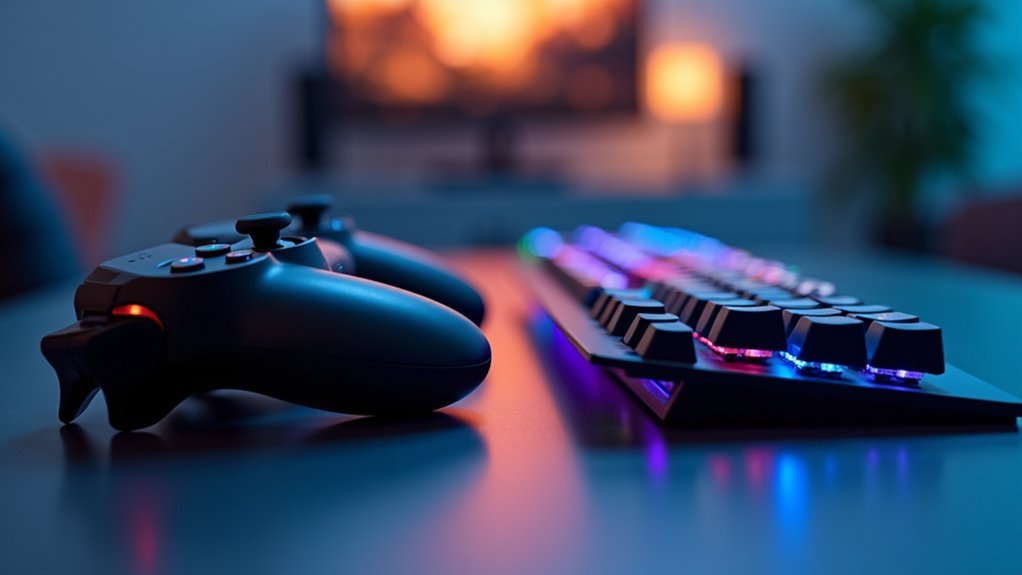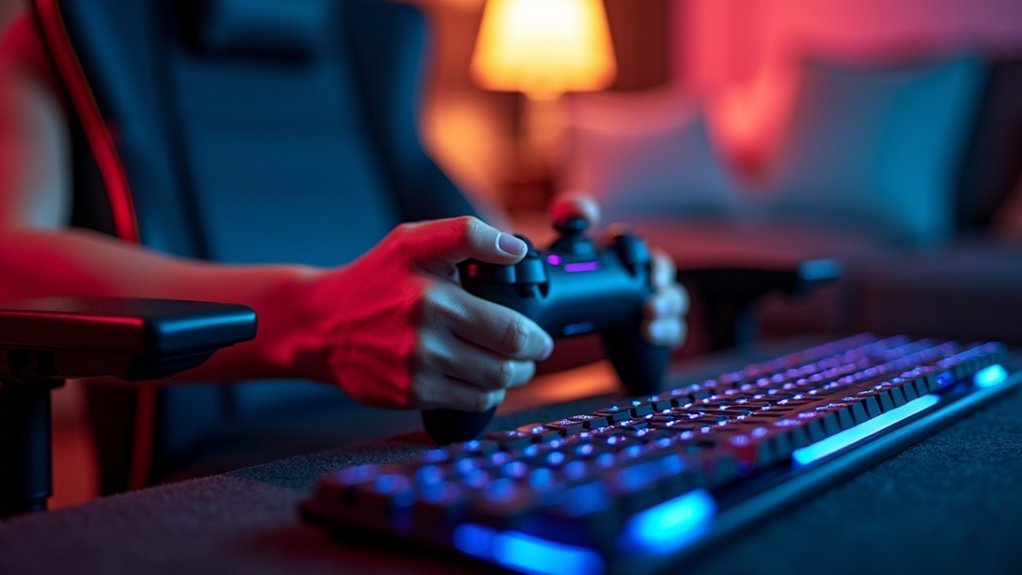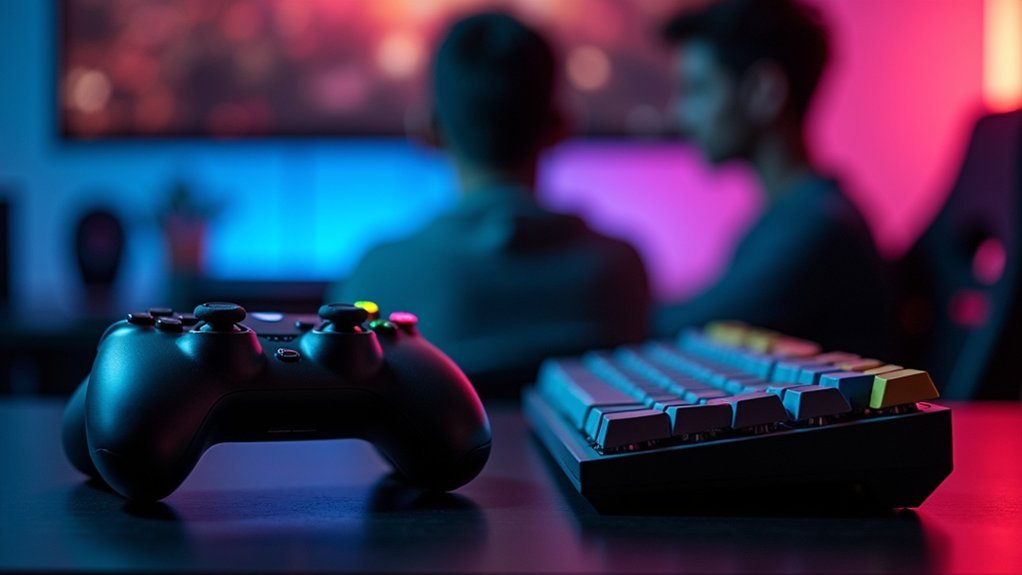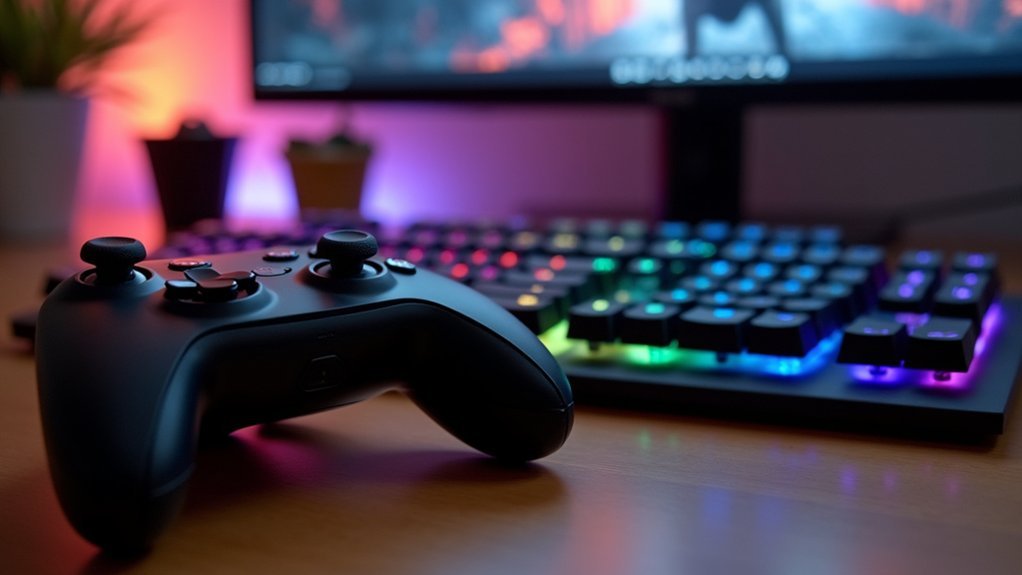You’ll need to evaluate your gaming priorities when choosing between VR controllers and keyboard-mouse setups. Controllers offer superior comfort with ergonomic designs, immersive haptic feedback, and natural motion tracking that enhances games like racing and action titles. However, keyboard-mouse combinations provide unmatched precision with 1ms response times and high DPI settings, making them ideal for competitive gameplay. Your decision should factor in genre preferences, comfort needs, technical performance requirements, and budget constraints to find your best gaming experience.
Understanding VR Input Device Fundamentals

Immersion defines the VR experience, and your choice of input device directly impacts how naturally you’ll interact with virtual worlds. VR input devices range from specialized hand controllers to traditional gaming input methods like keyboards and mice.
Hand controllers enable natural hand movements through motion tracking technology, creating seamless gesture-based interactions. This technology precisely translates your physical movements into virtual actions, enhancing immersive gameplay.
Motion tracking technology bridges the gap between physical movement and virtual interaction, making digital worlds feel remarkably real and responsive.
Haptic feedback adds another dimension by providing tactile sensations that simulate real-world touch. You’ll feel vibrations, resistance, and textures that make virtual objects seem tangible.
However, ergonomic design becomes essential during extended sessions. Your controllers must accommodate different hand sizes and grip preferences comfortably. Understanding these fundamentals helps you evaluate which input method best suits your gaming style and comfort needs.
Precision and Accuracy Comparison in Virtual Reality
When precision matters most in VR gaming, you’ll notice significant differences between controller and keyboard input methods.
VR controllers excel at creating an immersive experience through motion tracking, but they can’t match the accuracy of a traditional mouse setup. You’ll find that analog sticks and buttons provide intuitive interactions, yet their limited range restricts precise aiming in fast-paced scenarios.
Hand-tracking technology enhances precision by letting you interact directly with virtual environments, though it still falls short of mouse accuracy.
You’ll experience movement latency with VR controllers that affects competitive gameplay, unlike the instant feedback from traditional setups.
Your choice depends on the game’s design—precision-reliant genres benefit from mouse controls, while immersive experiences thrive with VR controllers.
Comfort and Ergonomics for Extended VR Sessions

When you’re spending hours in VR, your hands will quickly tell you whether you’ve made the right input choice.
Controllers feature ergonomic curves and textured grips that naturally cradle your hands, while keyboards force you into flat, rigid positions that weren’t designed for virtual worlds.
You’ll notice the difference most during extended sessions, where controller grip design notably reduces hand fatigue compared to traditional keyboard layouts.
VR Controller Grip Design
Marathon gaming sessions demand controllers that won’t leave your hands cramping or aching, and VR controller manufacturers have responded with thoughtful ergonomic designs that prioritize long-term comfort.
VR controllers feature specialized ergonomic grips that greatly reduce hand fatigue during extended gameplay. These thoughtfully engineered devices incorporate textured surfaces and contoured shapes that promote natural hand positioning, enhancing grip stability throughout your sessions.
Key design elements that maximize comfort during gaming include:
- Balanced weight distribution – Strategic placement prevents wrist strain during prolonged use
- Adjustable security straps – Integrated grips secure controllers while maintaining movement freedom
- Customizable grip options – Tailorable fits accommodate different hand sizes and shapes
You’ll find that modern VR controllers prioritize your physical well-being, allowing you to focus entirely on immersive experiences rather than physical discomfort.
Extended Session Hand Fatigue
Fatigue becomes your biggest enemy during those epic six-hour VR adventures, but controllers consistently outperform keyboards when it comes to keeping your hands comfortable throughout extended sessions.
Controllers are ergonomically designed with natural contours that support your hand positioning, greatly reducing strain compared to flat keyboard layouts. You’ll experience smoother, less fatiguing movements through analog sticks rather than repetitive key clicking and pressing.
Modern controllers enhance comfort with textured grips and adjustable weights, providing a relaxed grip that eliminates constant hand elevation.
Research confirms that you’ll report considerably less discomfort in your hands and wrists during prolonged gaming when using controllers versus keyboard setups, making them the superior choice for hand fatigue prevention.
Game Genre Compatibility With VR Input Methods
You’ll find that different VR game genres require specific input methods to maximize your gaming experience.
Motion controllers excel in action games and FPSs where you’re physically aiming and moving, while hand tracking shines in puzzle games that need precise finger movements.
The haptic feedback systems vary considerably between input types, with motion controllers offering stronger vibrations for combat scenarios and hand tracking providing subtle tactile responses for delicate interactions.
VR Motion Controller Essentials
When selecting VR motion controllers, understanding how different game genres leverage these input devices can greatly impact your gaming experience.
These controllers truly shine in specific gaming scenarios where immersive interaction enhances gameplay mechanics. VR motion controllers excel in rhythm games and simulations, where your hand movements directly translate into engaging experiences.
Action-adventure games benefit considerably from intuitive combat gestures and exploration mechanics that let you physically mimic in-game actions. The natural manipulation of objects in puzzle and platformer games creates enhanced problem-solving immersion.
However, consider these essential compatibility factors:
- First-person shooters often struggle with precise aiming requirements, favoring traditional gamepad setups.
- Racing games provide authentic driving experiences through realistic steering motions.
- Simulation titles maximize controller potential through direct physical interaction.
Hand Tracking Advantages
Hand tracking technology eliminates the need for physical controllers entirely, opening new possibilities for natural interaction across VR gaming genres.
You’ll find this particularly effective in exploration and puzzle-solving games where intuitive hand movements enhance gameplay. In rhythm games and fitness applications, hand tracking boosts immersion by translating your physical gestures directly into game actions.
Action-adventure and first-person shooter games benefit from hand tracking’s tactile experience when you’re aiming and interacting with environments.
Most VR games offer customizable gesture controls, letting you tailor your experience based on comfort preferences. However, effectiveness varies by genre—simulation and creative games excel with detailed manipulation, while fast-paced competitive games may still require traditional controllers for precision.
Haptic System Comparisons
While hand tracking offers natural interaction, haptic feedback systems in controllers deliver tactile sensations that greatly enhance immersion across different VR game genres.
Controllers excel at providing nuanced vibrations and resistance that keyboards simply can’t match in VR environments.
Different game genres benefit uniquely from advanced haptic systems:
- Racing and simulations – Feel vehicle dynamics, road textures, and environmental resistance through sophisticated controller input.
- Horror and exploration – Experience subtle environmental cues and heightened tension through tactical vibrations that signal danger.
- Action and adventure – Sense weapon recoil, surface textures, and impact feedback during combat sequences.
PlayStation VR controllers exemplify how immersive features transform user interaction.
You’ll miss these tactile elements with keyboard setups, making controllers essential for maximizing VR’s sensory potential across various gaming experiences.
Immersion and Haptic Feedback Considerations
Although precision and accuracy often dominate gaming discussions, the immersive qualities that controllers provide through haptic feedback can’t be overlooked.
Modern controllers like PlayStation’s DualSense create tactile sensations that simulate in-game actions—you’ll feel explosion impacts and surface textures directly through your hands. This haptic feedback, combined with responsive vibration motors, transforms your gaming experience beyond visual and auditory elements.
Haptic feedback turns controllers into sensory bridges, letting players physically experience every texture, impact, and vibration within their virtual worlds.
The ergonomic design guarantees comfortable extended play sessions, while the intuitive layout enables quick reactions and seamless interaction with on-screen elements. You’ll develop a deeper connection to the game world as these features work together.
Keyboard and mouse setups typically lack integrated haptic feedback, offering superior precision and control but missing the immersion that tactile sensations provide during action-packed gameplay.
Learning Curve and Adaptation Requirements

Beyond the physical sensations that enhance your gaming experience, you’ll face a steep learning curve when switching between input methods. Adapting from controller to keyboard and mouse requires developing new muscle memory, which demands patience and practice.
You might experience initial frustration with complex games like Cyberpunk, but this adjustment process is essential for long-term improvement.
The learning curve varies based on your approach:
- Gradual adjustment – Start with controller support while slowly incorporating keyboard and mouse mechanics
- Genre-specific adaptation – Choose input methods based on game types and your comfort level
- Performance investment – Dedicate time to mastering keyboard and mouse for competitive advantage
Understanding each method’s unique benefits helps you navigate adaptation challenges more effectively, ultimately enhancing your overall performance.
Technical Performance and Response Time Analysis
When you’re evaluating input methods for gaming, technical performance differences between controllers and keyboards become essential factors that directly impact your competitive edge.
Mouse response times can reach as low as 1 ms, while controller support typically delivers up to 8 ms latency. High DPI settings on gaming mice enable precise, rapid movements important for competitive scenarios.
Gaming mice deliver superior responsiveness with 1ms response times versus controllers’ 8ms latency, providing crucial competitive advantages through high DPI precision.
Keyboard inputs offer superior complexity through extensive key layouts, allowing you to execute complex commands and macros efficiently. Gaming mice achieve polling rates up to 1000 Hz, ensuring ideal input responsiveness compared to controllers’ lower rates.
However, analog sticks provide smoother continuous motion control, particularly beneficial for racing games and platformers requiring gradual directional adjustments that digital keyboard inputs can’t replicate effectively.
Cost and Accessibility Factors for VR Gaming
VR gaming presents distinct cost barriers that differ considerably from traditional controller and keyboard setups. Entry-level headsets start around $200, but high-end models exceed $1,000 with additional equipment.
Standalone headsets like Oculus Quest improve accessibility by eliminating the need for powerful gaming PCs, making VR gaming more affordable for broader audiences.
Your cost considerations include:
- Hardware investment – Entry-level headsets ($200) versus premium models ($1,000+) plus controllers and sensors
- Gaming area requirements – Physical space needs for safe movement, potentially requiring room modifications
- Software expenses – Game prices range from free experiences to $60 AAA titles
Accessibility extends beyond cost through adjustable settings that accommodate different abilities and comfort preferences, ensuring VR gaming becomes inclusive for players with varying needs and budgets.
Frequently Asked Questions
Is It Better to Play With Controller or Keyboard?
You’ll find controllers better for racing, fighting, and platformers due to analog control and comfort. However, you’ll achieve greater precision with keyboard and mouse for shooters and strategy games requiring quick, accurate responses.
How to Change Controls From Controller to Keyboard?
Access your game’s settings menu and find the “Controls” or “Input” section. You can customize key bindings there, or simply unplug your controller to automatically switch to keyboard input.
Do Pro Gamers Use Keyboard or Controller?
Pro gamers use both depending on the game. You’ll see keyboard and mouse dominating FPS competitions for precision, while controllers rule fighting and racing games for their intuitive analog controls.
How Do I Choose a Keyboard and Mouse?
You’ll want mechanical switches for tactile feedback and durability. Choose adjustable DPI settings matching your gaming style. Look for programmable buttons and ergonomic designs to reduce strain during extended sessions.
In Summary
You’ll find the perfect VR input method by weighing your priorities. If you’re seeking maximum immersion and haptic feedback, controllers win hands down. For precision tasks and familiar interfaces, keyboards can’t be beaten. Consider your budget, physical comfort, and preferred game genres. Don’t overthink it—you can always experiment with both options. Trust your instincts about what feels natural, and remember that your choice isn’t permanent. Start gaming and adapt as you discover your preferences.





Leave a Reply